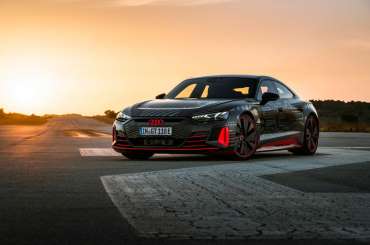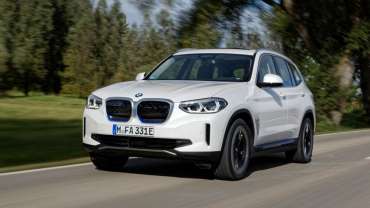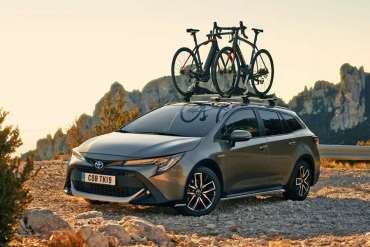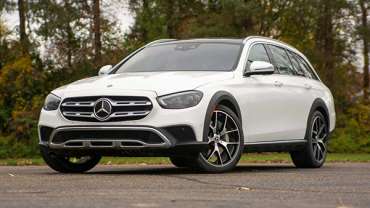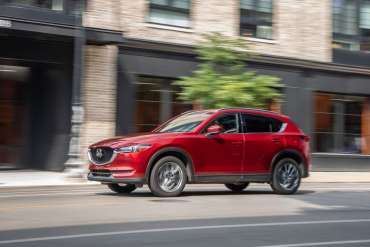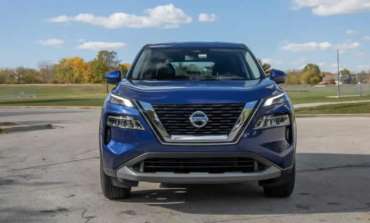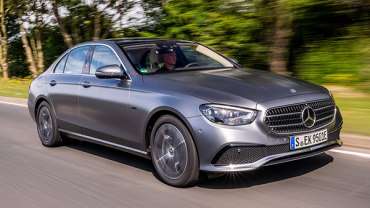
Worldcarblog.com
2022 Audi RS e-tron GT Charges after the Taycan
An early drive of Audi's version of the Taycan reveals some worthy differences.
Despite being part of the same company, Audi and Porsche continue to compete like old rivals. Both companies share an electric-car platform dubbed J1, and both are building similar battery-powered models atop it. Porsche's Taycan launched about a year ago, and now Audi is letting us sample its gorgeous e-tron GT. We spent a day behind the wheel of a camouflaged RS e-tron GT—that's the spicy one—the 590-hp version with the 670-hp Taycan Turbo in the crosshairs.
The hardware that gives the Taycan such impressive handling and acceleration carries into the e-tron GT. This includes two electric motors that provide all-wheel drive, a liquid-cooled 83.7-kWh lithium-ion battery pack, a two-speed rear transmission, three-chamber air springs, rear-wheel steering, and a torque-vectoring rear end.
Under overboost conditions and when using the launch-control function, the estimated 590 horsepower temporarily rises to around 637 horsepower. We expect the sprint to 60 mph will take about 3.0 seconds, and top speed is governed at 155 mph. The basic e-tron GT will make 510 horsepower, or 12 horses fewer than a Taycan 4S.
On the tight, sometimes slippery but rather empty roads on the Greek island of Rhodes, the RS e-tron GT was able to show off its handling. After the drive, Audi set up a drag race where speeds reached an indicated 135 mph. The shift from first to second gear, by the way, was clearly noticeable under full acceleration, but it is barely noticeable on the road, where the upshift happens around 45 mph in Sport mode. In range-optimized modes, the RS e-tron takes off in second gear.
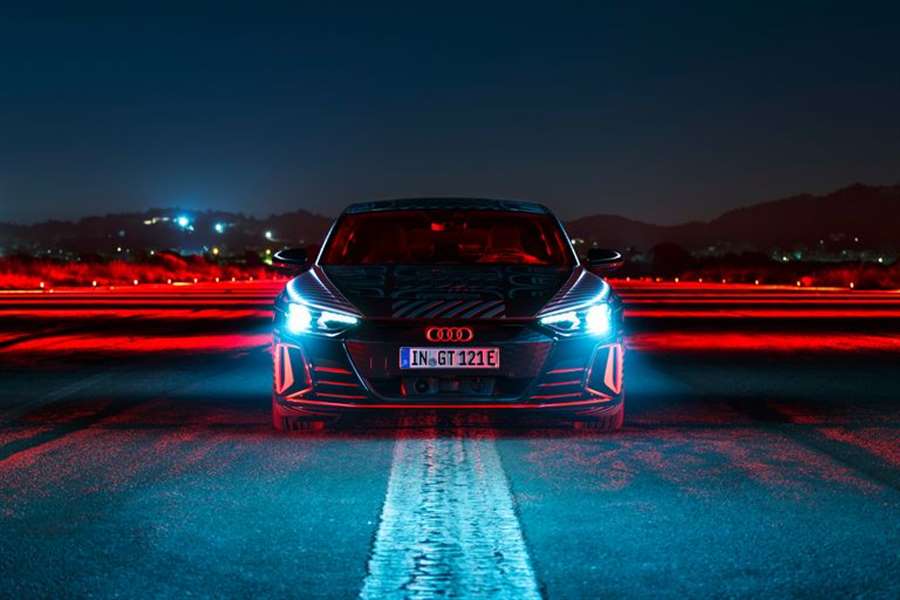
The suspension tune is rather soft, but the adaptive dampers stiffen in an instant. Lightning-quick step-off acceleration and the variable torque distribution give the e-tron GT nearly all of the agility and acceleration of the Taycan Turbo S. This is despite a claimed 4600-pound curb weight, which we think will be closer to 5000 when United States-spec cars are finalized. Audi engineers left in a bit of body roll, giving the driver a good sense of reaching the limits of adhesion, while the steering is pleasantly light. The RS e-tron GT is a fantastic performer, but it has a distinct character. It feels a bit less darty than the Taycan, and it is a bit more comfortable and relaxing on long drives.
Inside, there is a wide, horizontal, and angular dash that takes the futuristic design of e-tron SUV to the next level. Audi concealed the instrument panel, but we took a peek and liked what we saw. As in the Taycan, driver and passengers sit low. But it's comfortable, and the room in the rear seat is ample. The e-tron GT has three seats in back. The middle seat is raised and narrow. The large steering wheel is a key differentiator from Taycan, the mirrors are conventional instead of camera-based units on European versions of the e-tron SUV, and Audi has resisted the trend of retracting door handles.
A fixed panoramic roof will be standard. A carbon-fiber roof is optional and reduces weight by 18 pounds. Like the Taycan, the GT is a sedan. There's a 12-cubic-foot trunk with a small opening and a frunk (front trunk) with 3 cubic feet of storage. Audi is considering adding a hatchback version, possibly because Porsche will be adding a hatchback Taycan Cross Turismo next year. The structure is largely made from steel with some aluminum components, and almost all body panels with the exception of the roof are made from aluminum.
The body has a beautiful shape, with a fastback look and the right amount of aggressiveness from its creases and bulging fenders. It's hard to imagine that Audi could have pulled off the design if they had to package a powerful gasoline engine under the hood. RS versions don't get too much external differentiation. Spotters will have to check the nose for a honeycomb pattern in the grille and, of course, the RS badges.
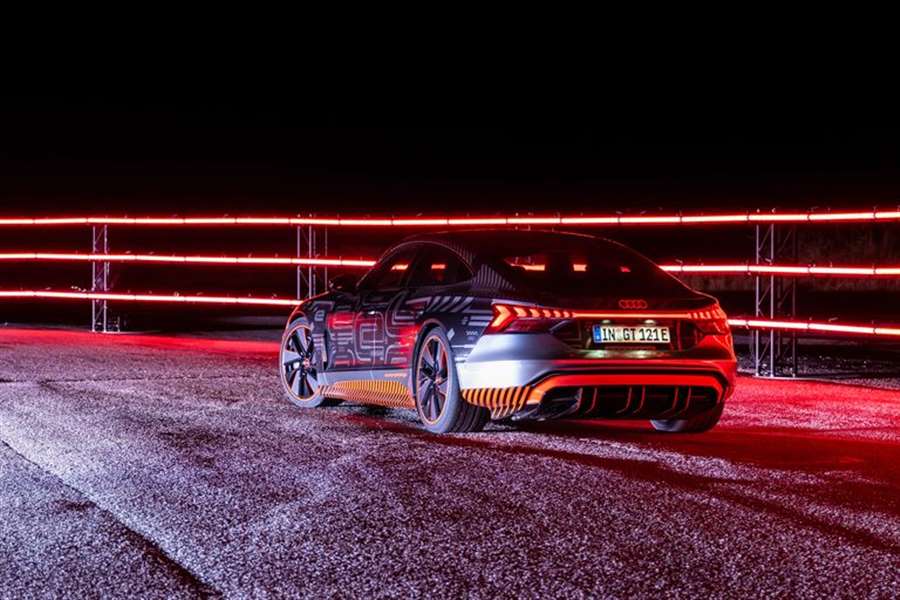
Audi claims a 249-mile range in the Euro cycle for the non-RS, but it isn't ready to release the details on the RS version. We'll assume it is less than the base model. Driven hard, we watched the range drop precipitously, so if you head out to hammer on the RS e-tron GT, set aside some time and a plan to recharge.
Final pricing is not yet available, but we're estimating a starting price the equivalent of $163,000, which makes the Audi RS e-tron GT about $12,000 less than the Taycan Turbo. We expect a similar difference when the Audi arrives in the U.S. next year, an important differentiator that works in the Audi's favor.
Source caranddriver.com
BMW iX3 SUV review
"The BMW iX3 is an electric variant of the popular X3 with a 285-mile range"
While BMW wowed the world with its i3 electric hatchback and i8 plug-in hybrid coupe, the all-electric BMW iX3 SUV is altogether a more staid proposition. This time round BMW is taking a similar approach to Peugeot and Hyundai by serving up an electric version of a car it already sells, namely the BMW X3.
There's been a deliberate decision not to go radical with the design, with BMW instead opting to add aerodynamic wheels, blue trim accents and a smoothed-off grille. There are also a new set of bumpers and side skirts, all tested to ensure they are slippery enough to help maximise the driving range. This is really just an X3 for buyers who want an electric powertrain.
Best electric SUVs
Under the car's floor is an 80kWh battery that sends its power to a rear-mounted 282bhp electric motor. This is a departure from rivals like the Audi e-tron, Jaguar I-Pace and Mercedes EQC, which all have two motors, four wheel drive and quite a bit more power. While it isn't as fast as them, the iX3's 285-mile range is competitive, beating both its German rivals and just slightly behind the I-Pace. The Jag’ struggles to hit its official figure in real-world driving anyway.
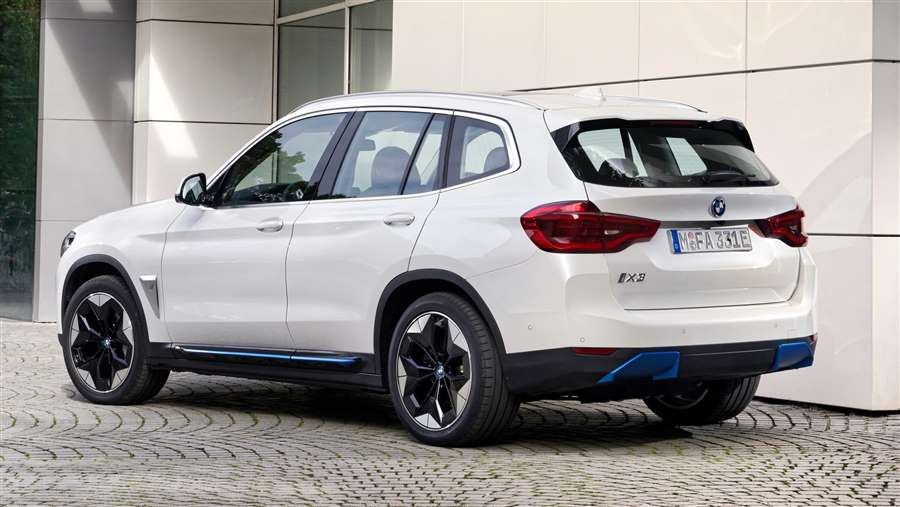
It can also be charged quickly, obtaining speeds of up to 150kW at the latest rapid-charging stations. Of its closest rivals, only the e-tron can match this, with the others topping out at around 100kW, and it means the iX3 battery can be replenished to 80% in a speedy 34 minutes. Thanks to this capability, making one stop on a long journey should be ample to get drivers to their destination with range to spare.
Like the exterior, the inside of the iX3 is very much a mild variation on the X3, with some flashes of blue trim to show this is the electric version. It shares the same 10.25-inch iDrive infotainment display perched above the dashboard and a 12.3-inch digital instrument screen. Premier Edition and Premier Edition Pro trims serve up plenty of equipment, with features like a head-up display, a Harman Kardon stereo and wireless phone charging in the top trim.
The BMW iX3 is spacious, quiet and has a good range, but it's a shame it doesn't feel anywhere near as special as the i3 and i8. Instead, it ushers in an era when electric BMWs will be a more mass-market part of the line-up.
By adding an EV option to its popular X3 range, BMW boasts that customers can now choose between four different powertrains for its mid-size SUV. It adds to the existing petrol, diesel and plug-in hybrid range, giving low to medium-mileage drivers the chance to shun traditional fossil fuels altogether.
BMW iX3 MPG & CO2
The iX3 has an 80kWh battery beneath its floor, allowing it to cover up to 285 miles on a charge. That's competitive with the 298-mile range of the Jaguar I-Pace, and betters the 237 and 256-mile range of the Audi e-tron and Mercedes EQC respectively.
Like the e-tron, the iX3 also supports rapid 150kW charging at compatible public locations, topping the battery up to 80% in just 34 minutes. The Mercedes and Jaguar can be topped up at around 100kW, so take longer to recharge.
As with any electric vehicle, the iX3 has the potential to significantly reduce running costs for the owner, and we particularly enjoyed one new feature for its energy recuperation system. Like most new EVs, the braking effect of the electric motor can be set to low, medium or high, and with practice it's possible to drive the iX3 in traffic with almost no use of the brakes. However, BMW has also added an ‘Adaptive’ setting, which automatically adjusts the recuperation to match the car ahead, a bit like adaptive cruise control for braking alone. It works well, carefully adjusting the regenerative effect to match cars in front, even when they modulate their deceleration.
Thanks to its zero emissions, the iX3 qualifies for free car tax and 0% BiK for company-car drivers in 2020/21.
Insurance groups
The insurance band for the iX3 hasn't been announced yet but it's likely to be fairly high. We say this because its rivals are all costly to insure, with the I-Pace in group 49 out of 50 and the Audi e-tron in the very top group. However, the iX3 is the least powerful of the group, so could be a few groups lower.
Warranty
BMW sells all its cars with a three-year/unlimited mileage warranty, which is on a par with Mercedes and slightly more generous than Audi (with a 60,000-mile cap). Tesla models come with a four-year or 50,000-mile warranty. It's likely the BMW iX3 will have a longer warranty covering its battery (many rivals offer eight years of cover), but details of this have yet to be announced.
Servicing
BMW models are fitted with an array of sensors to determine when servicing is required, so there isn't a strict routine to stick to. Typically, services won't be more than two years or 20,000 miles apart, and isn't the cheapest. BMW does offer servicing packages though, making it possible to spread the cost over monthly payments.
Unlike its rivals, the iX3 gets a single electric motor powering the rear wheels. This means it isn't as quick as the dual-motor Jaguar I-Pace in a straight line, but it still gets a sporty setup in typical BMW fashion.
In fact, it would have been better if BMW had made the suspension softer because in its pursuit of agile, fun handling, ride comfort has been compromised. Even in the softest Comfort mode, the iX3 fidgets and seems to find bumps in the road that look inconsequential from behind the wheel.
This chassis setup and the low-slung battery does at least mean the iX3 corners with little body lean, while the steering is fast to respond, if lacking in feel. Sport mode makes the steering heavier but also renders the suspension too bouncy, so we quickly turned it off.
BMW iX3 electric motor
The iX3 is powered by a single 282bhp electric motor at the rear axle, giving it a 0-62mph acceleration time of 6.8 seconds. This should be plenty quick enough for most SUV (and EV) buyers, but it's some way off rivals. The Audi e-tron, Jaguar I-Pace and Mercedes EQC all feature front and rear motors, providing more power and four-wheel drive.
The iX3 accelerates very quietly, with just a distant whine from its electric motor. If you prefer, you can also choose a louder sound thanks to 'balanced' and 'sporty' settings. The iX3 glides away from a standstill smoothly, with instant pulling power doing a good job of disguising its 2,185kg weight.
Interior & comfort
Unlike the daring BMW i3 and i8 models that set out BMW's stall as a designer of forward-thinking green models, the iX3 is a much more conventional model that's also available with electric propulsion. This will make sense for many customers, while others may view it as a bit of a disappointment.
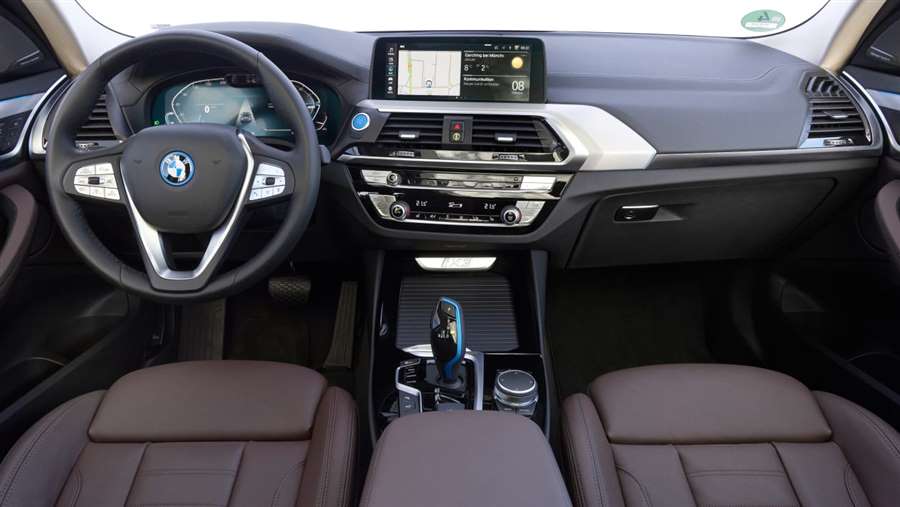
If you've sat in a BMW X3, there's very little change here apart from some blue flashes of colour for the BMW badge and gearlever. The steering wheel with silver buttons is new, while a 10.25-inch infotainment display and 12.3-inch digital instrument cluster is carried over, with Apple CarPlay and Android Auto.
Materials are of a high quality and the infotainment software is amongst the best in the business, but there aren't any novel features like trim made from recycled bottles or cork, as seen in many environmentally conscious models.
Equipment
The first versions of iX3 will be called Premier Edition and Premier Edition Pro, with four exterior colours offered, along with two choices of exterior trim colour: aluminium or gloss black. Standard kit includes wireless smartphone charging, heated front seats and Driving Assistant Professional.
Premier Edition Pro is distinguished by large 20-inch aerodynamic alloy wheels, along with a powered tailgate, adaptive suspension and a panoramic sunroof. It also boasts a plethora of tech like a head-up display, Harmon Kardon stereo, gesture recognition and a BMW IconicSounds Electric soundtrack developed with famous composer Hans Zimmer.
If there are concerns the iX3 is compromised compared with the regular model, fear not. It's virtually as usable for a family of five as the petrol or diesel car, and the boot is actually larger than the one in the plug-in hybrid BMW X3.
BMW X3 interior space & storage
There's plenty of space for adults in the front and back of the iX3 to stretch out, with the battery placed out of the way beneath the car's floor. In reality, most won't need the extra space found in the larger BMW X5 but there's no option of a third row of seats to make the iX3 into a seven seater.
Boot space
The iX3 has a 510-litre boot, which is 40 litres smaller than the petrol and diesel BMW X3 offer. In reality, most will be hard pressed to tell the difference, and surprisingly this is 60 litres more than the plug-in hybrid version of the X3 offers. The electric motor and transmission featured here is actually more compact than in the PHEV, so takes up less space.
Source: carbuyer.co.uk
Toyota Corolla Trek
"Go anywhere looks for faux off-road Corolla wagon"
Take the recently introduced Corolla Touring Sports estate, elevate the ride height, add some cladding to the bodywork and the result is this – the Toyota Corolla Trek.
Those of you with longer memories will recall the Toyota Tercel – a rugged-yet-compact four-wheel drive estate from the mid-1980s. This is not quite the same thing remixed for a modern audience, primarily because the Corolla Trek is front-wheel drive only, with no sign of a 4x4 model on the horizon.
In an admittedly small market sector where two of its key rivals – the Skoda Octavia Scout and Volkswagen’s Golf Alltrack – are available with four-wheel drive, that may be a limiting factor, but closer in spirit to the Toyota is the Ford Focus Active Estate, also an exclusively front-wheel drive model.
Unlike the Ford, there’s no Trek based on the Corolla hatchback body, but that would be a relatively straightforward addition if the market demand is there.
Will the Toyota Corolla Trek be good off-road?
It doesn’t look like it. While it does appear to be aimed at those with more adventurous lifestyles, it won’t be able to compete with more focused SUVs, such as Toyota’s own RAV4 and Land Cruiser.
Toyota Corolla Trek rear three-quarter
The Trek name comes from the bicycle brand Toyota has partnered with, a move which clearly highlights their intended market for this variant – keen mountain adventurers should take note. Compared with the regular Corolla Touring Sports estate, the Trek enjoys a 20mm increase in ride height, which isn’t going to take you very far off road, so a bike mounted on the roof would prove useful.
Toyota Corolla Trek: limited changes for an SUV look
Clearly the Corolla Trek is not a crossover, but a halfway house between a regular estate and an SUV, so visual changes from the Touring Sports are limited.
Outside, stylistic changes are restricted to chunkier bumpers complete with skid plates front and rear to lend an air of off-roading authenticity.
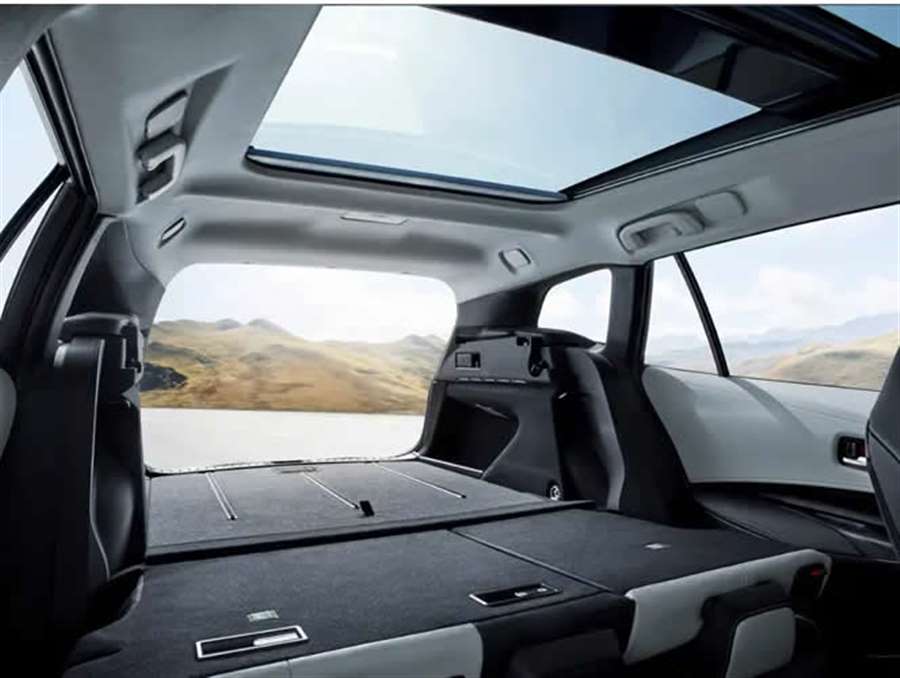
We’ve yet to see images of the interior, but Toyota’s referenced two-tone seat trim and wooden decorative panels. Whether this ‘wood’ is actually related to anything that was once a tree remains to be seen.
Toyota Corolla Trek: exclusively hybrid power
Cars with genuine off-road capability have long been most popular with diesel engines, but as Toyota’s ditching these kind of motors for its mainstream models, the Corolla Trek will be petrol-electric hybrid-only.
However, there’s a choice of two powerplants seen in the regular Corolla models: a 122hp 1.8-litre, which lacks low-range torque, but a much more powerful 180hp 2.0-litre should provide a considerably more pulling power when required.
Precise performance, economy and emissions figures will be released in due course
Source: parkers.co.uk
Mercedes-Benz E 450 All-Terrain 2021 Review
Once upon a time, station wagons dominated America’s roadways. They were the preferred mode of transport for frugal families road-tripping across the country until the arrival of the minivan. Today, wagons make up a sliver of new vehicle sales. That’s despite a surge in models that blur the lines. Traditional wagons exist and continue to appeal to consumers looking for something different, but high-riding, ruggedized long-roofs are becoming more and more common.
Subaru is the most successful purveyor of this sort of car, but Volvo has its Cross Country range and Audi is expanding the Allroad line with a new A6 Avant-based model. These vehicles attempt to marry the appeal of wagons – that they’re interesting, different holdovers of another time – with the air of capability that makes crossovers popular. For 2021, Mercedes-Benz is getting in on the action, discontinuing its E450 Wagon and introducing the E450 All-Terrain.
Packing a standard air suspension , a boost in ground clearance, and some rugged body mods (not to mention the same changes introduced on the broader E-Class line for 2021) does mean added capability. But even with these new touches, this high-riding wagon feels too much like its traditional counterpart in a few important ways.
Looking The Part
The E-Class All-Terrain’s new headlights, more prominent grille, and tweaked front bumper conspire to produce a more premium, attractive face than last year’s E-Class Wagon. And where the back of the revised E sedan looks worse than its predecessor, the designers left well enough alone on the wagon, retaining the slim, horizontal taillights and a wide-opening aperture with a low lift-over height.
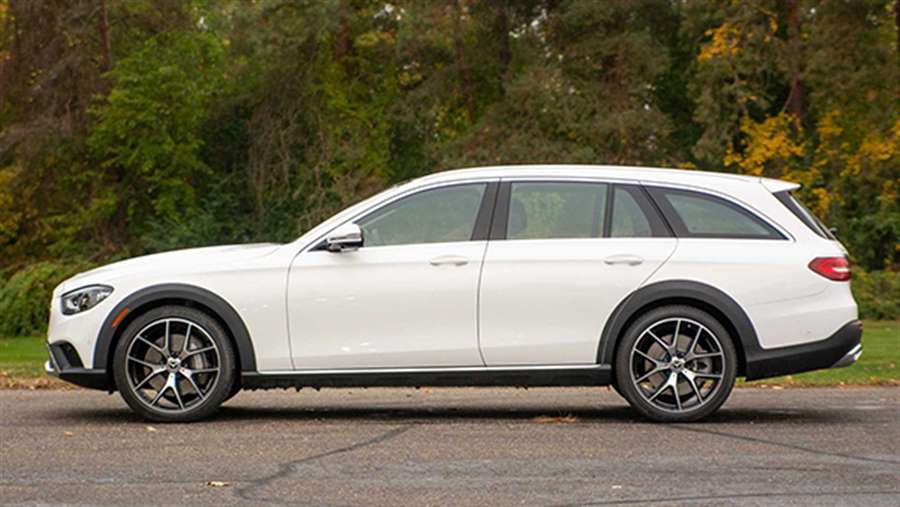
The All-Terrain differs from its predecessor, though, with prominent black plastic around its wheel arches and side sills. The 2021 model is no wider than last year – both cars span 73.7 inches, not including the mirrors – but there is a subtle flare to the arches that produces more visual mass. There’s also black plastic on the front and rear bumpers, although the protection on offer is minimal (this is no G-Wagen).
The car’s stance is more purposeful, although our tester left us scratching our head with its optional 20-inch wheels.
Completing the tougher look is a boost to the E450’s ride height. The now-standard air suspension offers 5.8 inches of ground clearance, 2.0 inches more than what you got from last year’s E450 Wagon. The car’s stance is more purposeful, although our tester left us scratching our head with its optional 20-inch wheels. They look good and are a visual benefit to the car overall, but big wheels and skinny sidewalls don’t give the impression of SUV-like toughness.
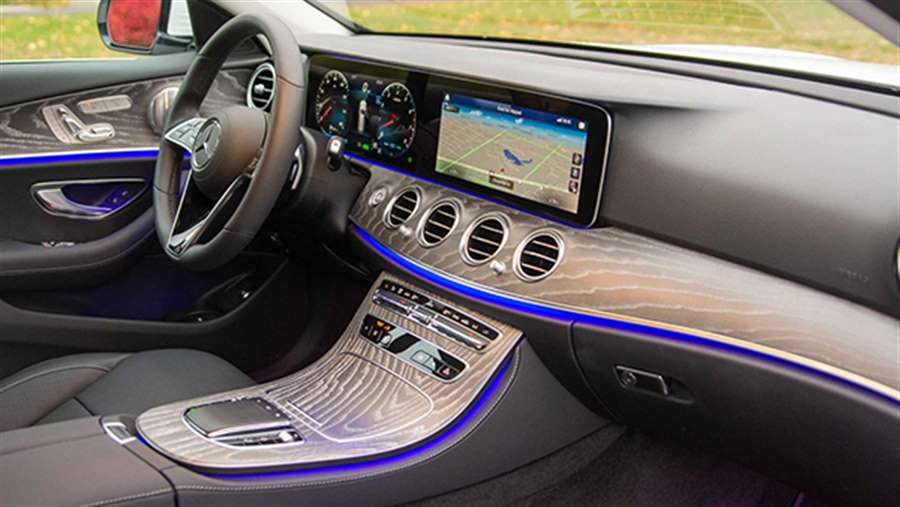
Mercedes made one significant change to the E-Class cabin, with every variant receiving a new steering wheel design. The company opted to replace physical buttons and scrollers with touch-capacitive controls. Some work, like the “buttons” that activate and adjust the cruise control. But the important controls – the volume slider and the directional pads for controlling the digital instrument cluster and infotainment system – tend to have a mind of their own.
Almost All Terrain
This is not a Mercedes problem, but these lifted wagons are rarely as capable as they look. In the E450 All-Terrain’s case, though, the bones are good. The air suspension allows up to an inch of height adjustment, and new Offroad and Offroad Plus driving modes, plus hill descent control, provide an easy avenue for tweaks to the suspension, stability control, and powertrain.
The chink in this car’s armor is, as is often the case, its tires. The E-Class is only available with 19- or 20-inch wheels with 245/45/19 or 245/40/20 tires, respectively. Our tester featured the larger option and was perfectly fine on smooth and paved roads. The soft air suspension soaks up abuse so well that you aren’t even aware you’re riding on rubber bands. But dirt roads are an anxiety-inducing experience, to the point that we can’t understand why Mercedes engineered dedicated off-road driving modes – they’re moot with the factory wheel/tire choices.
It’s a miracle the E450 survived our dirt-road session without a flat tire.
We integrated 90 minutes of dirt-road driving – typical stuff for rural Michigan – into our usual test loop, and it’s a miracle the E450 survived without a flat tire. Bumps that didn’t look all that significant sent a groan-inducing shudder through the body, preceded by the instantly identifiable clunk of a wheel accepting forces that the tire should handle. While it hurts the aesthetics, the first thing we’d do with an E450 All-Terrain is drop the wheel diameter to 17 or 18 inches and then fit the thickest sidewalls the car could accommodate without rubbing – there’d be a dramatic improvement in dirt-road comfort.
Still Works As A Wagon
Despite the All-Terrain treatment, the E450 still works as a suburban runabout. Packing a new engine for 2021 – a non-AMG version of the E53’s turbocharged, mild-hybrid straight-six – and standard all-wheel drive, this wagon offers innocuous performance around town. There’s 362 horsepower and 369 pound-feet of torque – identical to the E450’s old twin-turbo V6 – and while Mercedes isn’t publishing a zero-to-60 time, we’d wager it remains in the five-second range.
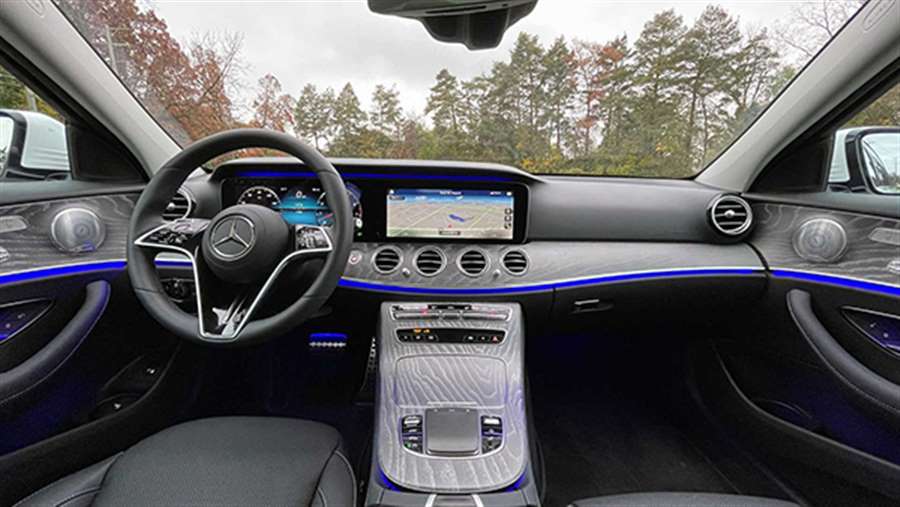
The 2021 E450 doesn’t feel any quicker than its predecessor, but the new mild-hybrid engine is far, far smoother. That’s partially down to the inline layout – arranging six cylinders in a row is inherently better than putting them in a V – but also thanks to the EQ Boost mild-hybrid system, which uses a 48-volt electrical architecture to power a compressor that immediately spools the turbocharger. The combo of these two things means that off the line, the All-Terrain accelerates like the more luxurious, refined car. The new engine is quieter, for a start, but what you hear is smoother and more pleasant, too.
Despite the All-Terrain treatment, the E450 still works as a suburban runabout.
Meanwhile, the added ride height has only a small impact on how the All-Terrain handles. There’s more body roll, which makes sense, but it’s easy to predict how the car will respond to inputs. Overall grip levels are high too, owing to the wildly inappropriate-for-an-off-roader Pirelli PZero rubber. This is an easy car to hustle about.
Price Is Still An Issue
Ultimately, and as was the case the last time we drove an E-Class Wagon, we’re still concerned about the cost of this variant and the limited number of configurations it’s available in. The All-Terrain only offers the 3.0-liter EQ Boosted straight-six, while its $67,600 starting price is over $10,000 more than a GLE 350 4Matic and $5,100 more than its nearest counterpart, the GLE 450.
Those points aside, the All-Terrain has one big pro we haven’t mentioned: exclusivity. Mercedes imports precious few wagons to the United States each year, making the E450 and its AMG counterpart, the E63, two of the company’s rarer vehicles. That hasn’t been enough to motivate customers in the past, but with a ruggedized alternative to the traditional wagon arriving in showrooms soon, it’s possible that Mercedes may see some more interest from American consumers looking for something different. Read more > https://mercedes-world.com/e-class/mercedes-benz-e-450-all-terrain-review
Source: mercedes-world.com
Our 2019 Mazda CX-5 Turbo Was Easy to Love
From its excellent road manners to its upscale interior to its perfect reliability over 40,000 miles, Mazda's compact crossover served us well.
You don't have to say "compact crossover" three times in a row to make one appear; the parking lot is already full of them. They've scared away most of their car counterparts, but it's crossovers like the Mazda CX-5 that make us think maybe the future isn't so spooky after all.
Our CX-5 arrived in the top Signature trim with flashy Soul Red Crystal Metallic paint and 19-inch dark-silver aluminum wheels. The leather-wrapped steering wheel and wood trim gave it a luxury feel despite its less than exorbitant price. The Caturra Brown interior combined good-quality dark dash materials with brown ventilated leather seats brought a very upscale finish to the cabin. A few accessories were added; all-weather floor mats went to good use, a rear bumper guard probably saved the CX-5 from a few blemishes, and a roof rack went largely unused.
A 250-hp turbocharged 2.5-liter four-banger and all-wheel drive come standard in Signature trims, but it's the 310 pound-feet of torque that gives the CX-5 an almost diesel-like power delivery. Print director Eric Tingwall pointed out, "This engine is tuned for a strong low-end tug from zero to 30 mph at about 50-percent throttle. When you floor the accelerator and ride it out through the relatively low redline, the engine feels a bit coarse and reluctant. I remember Mazda saying something about zoom-zoom, but this engine doesn't have any of that spirit." At 40,000 miles, however, the 2.5 did show a little more enthusiasm, delivering better acceleration times across the board.
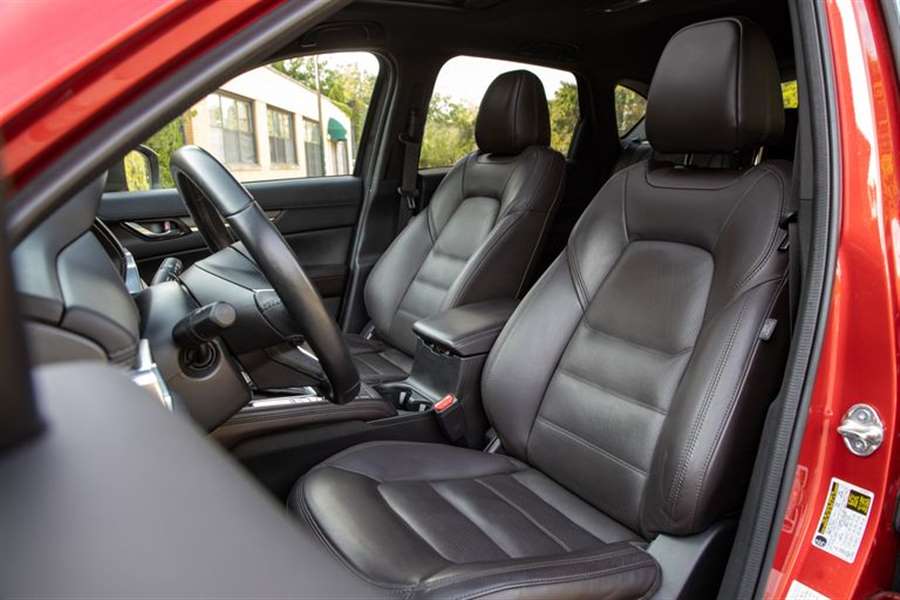
But that tuning makes sense for the small-crossover use case, which doesn't typically involve regular trips to redline. It does involve regular trips, however, and on that front the CX-5 was often passed over in favor of more capacious competitors. We found the CX-5 stylish inside and out and a pleasure to drive, but its tight cargo space and lack of towing capability explains why it was overlooked for family trips. There were several staffers who asked about it having a trailer hitch—no, it didn't—but even if it did, the CX-5 maxes out at a 2000-pound tow rating. Other long-termers with more cargo space, like the Honda Passport, were often selected ahead of the Mazda despite the CX-5 delivering a more upscale driving experience.
LOWS: Lack of cargo space and not the most fuel-efficient commuter.
The CX-5 completed its test without any hiccups or gaffes, despite being rummaged through by a would-be car thief. We took it to Mazda for six scheduled maintenance visits throughout its long-term test, regular 7500-mile services, and an additional stop right at 40,000 miles to replace the spark plugs. That cost $293, although at the same time the dealer noticed that we were wearing thin of rear brake pad and that those rotors were also warped. Add $574 to the normal-wear column. In terms of reliability, the CX-5 couldn't have been more consistent if it had taken a fiber pill every morning.
The most frequent gripes concerned the Mazda's tiny and slow infotainment system. Sometimes the menu would just freeze after startup or get stuck in a loading cycle when switching between menus. This system has since been upgraded for 2020 models, solving its lagginess. We've been in a new CX-5, and the larger 8.0-inch touchscreen is also a big improvement.
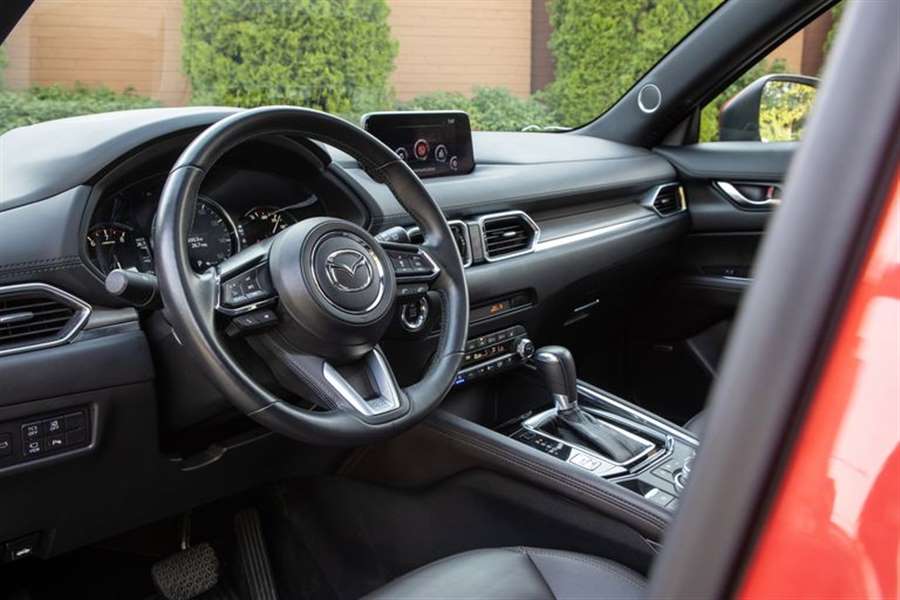
How much we like driving this 10Best-winning vehicle should not be diminished by how long it took us to reach 40,000 miles. We took delivery in March 2019 and only made it to 30,000 miles a year later, before quarantine started. It took another six months to knock out the last 10,000 miles. In contrast, our long-term Kia Telluride reached 10,000 miles in only its first three months, but its three rows and usable tow rating makes it far more friendly for a road trip with four or more people.
The CX-5 took us plenty of places, just nowhere very far from home. Most trips were local. It did a lot of commuter work (back when we were still commuting to work), and it ran a lot of errands. Assistant technical editor Maxwell Mortimer was the long-distance champ, venturing as far south as Tellico Plains, Tennessee, and driving 200 miles north of the office to Harrisville, Michigan for a camping trip. We averaged 24 mpg, matching the combined EPA-estimated mileage. We achieved 30 mpg during our 200-mile highway fuel-economy test near the 40,000 mile mark, which also matches the EPA's estimate, but it's still behind the all-wheel-drive Toyota RAV4, Nissan Rogue, and Honda CR-V. But we'd rather burn fuel in the CX-5.
After 40,000 miles we still appreciate the luxurious look and feel of the CX-5's comfortable leather seats, as well as its six-speed automatic transmission in a field rife with continuously variable automatics (CVTs). We wish its competition could step it up and offer the same effortless steering and controlled suspension as the CX-5—or that the Mazda could provide the cargo space of a Honda CR-V or Nissan Rogue. The perfect crossover doesn't exist, but we respect the CX-5's prioritization of the driving experience. Better to be really good at one thing rather than mediocre at everything.
Months in Fleet: 18 months Current Mileage: 40,206 miles
Average Fuel Economy: 24 mpg
Fuel Tank Size: 15.3 gal Observed Fuel Range: 360 miles
Service: $971 Normal Wear: $574 Repair: $0
Damage and Destruction: $0
30,000-Mile Update
The past 30,000 miles of our long-term test with the turbocharged Mazda CX-5 have been trouble-free, uneventful bliss. It’s been the type of ownership experience you’d hope for with any vehicle. There hasn’t even been a single unscheduled maintenance visit or factory recall yet.
The CX-5 has drawn some unwanted attention, though. One night, while parked at a C/D staffer’s apartment complex, someone got into the presumably unlocked CX-5 and rummaged through the glove compartment and center console but left without stealing anything—and we had a bag of tools and a USB cord in there. It’s possible the would-be thief was scared off by something, but it makes us think that this CX-5 is a lucky one.
The 250-hp turbocharged 2.5-liter inline-four under the hood remains a staff favorite. That said, there are a few entries in the logbook that criticize the moment of turbo lag that exists at low rpm. And some staff members complain that this engine lacks power when you twist the tach past 5000 rpm. Quipped deputy reviews editor Tony Quiroga, “This engine makes low-end power and runs out of enthusiasm at high revs like a Fox-body Mustang ‘5.0’ V-8. The quotes are there of course because that engine is actually a 4.9-liter.”
We continue to be grateful that Mazda employs a six-speed automatic instead of a CVT. Shifts are crisp and quick, and the CX-5 never suffers from the dreaded droning sound that CVTs utter under acceleration. We do enjoy the faint sighs of the turbocharger’s pressure relief valve recirculating air on most shifts.
To celebrate his completion of a two-week quarantine after returning from a press trip in Italy, assistant technical editor Maxwell Mortimer took a 1400-mile road trip to the Tennessee–North Carolina border just before Michigan’s shelter-at-home decree hit. He writes that “the CX-5 is awesome. I can’t help but keep comparing its level of entertainment with a Volkswagen GTI's.”
Senior editor Joey Capparella also took it on a trip to Tennessee, where he noted the CX-5’s unexceptional highway fuel economy: “I had to fill up about every 350 miles or so. Out of boredom, I tried to get the low-fuel warning light to show zero, but I chickened out at 17 miles.”
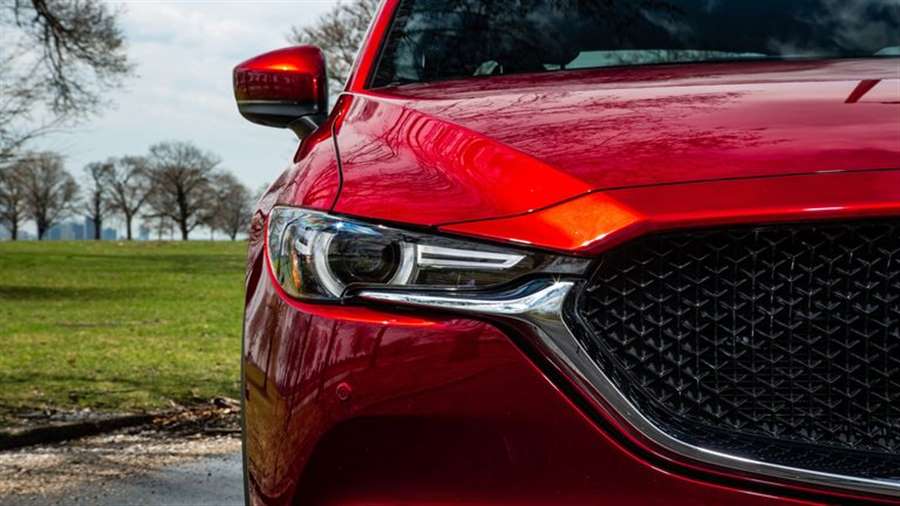
The CX-5 appears to have a very conservative fuel gauge, though, because when Capparella compared the tank size with the quantity he pumped, the Mazda had over two gallons left in the tank. During Capparella's trip, his average fuel economy registered 29 mpg, or 1 mpg short of what an identical CX-5 managed during our 200-mile highway fuel-economy test. Had he wanted to, Capparella could have likely pushed it beyond 400 miles before having to seriously start looking for a gas station.
Since our last update, we’ve maintained a steady 24 mpg in combined driving. Currently, the CX-5 is driving on Nokian Hakkapeliita R3 SUV winter tires, which have taken the worst the winter could throw at them. Now that spring is here, we’ll be swapping to the original equipment: Toyo A36 all-season rubber.
Inside, the nappa-leather-trimmed driver’s seat is beginning to become a bit glossy as more and more butts slide in and out of it. Small creases and wrinkles are appearing, too. Left alone and in the warmest setting, the heated seats reach uncomfortably hot temperatures. Within minutes, you end up turning them off for fear of searing yourself. The 7.0-inch touchscreen is a bit frustrating, as it often lags and takes a long time to boot up when you turn on the CX-5. You find yourself waiting for it to load, stuck watching a gear icon spin on the screen for about 20 seconds. It’s one of the few gripes we have, though, as the rest of the interior has an upmarket design and feel.
We still have 10,000 miles to go before our loan ends. We'll see if the CX-5 can maintain its perfect reliability record. We look forward to the day when we can take it for another road trip. Right now, we’ll have to settle for quick runs to the grocery store.
Months in Fleet: 13 months Current Mileage: 30,375 miles
Average Fuel Economy: 24 mpg
Fuel Tank Size: 15.3 gal Observed Fuel Range: 360 miles
Service: $574 Normal Wear: $0 Repair: $0
Damage and Destruction: $0
20,000-Mile Update
It has taken nearly a year for our long-term Mazda CX-5 to cross the halfway point in its 40,000-mile stay with us. But that gradual mile accumulation is not for the Mazda's lack of goodness as a compact SUV. While we're not petty enough to shy away from the CX-5's handsome styling, excellent driving character, and trouble-free reliability because of its irksome infotainment system, that aging interface is about the only thing we have been able to consistently criticize.
Indeed, our Mazda is so agreeable that most of the very few entries in its logbook center on the small 7.0-inch infotainment display and both its slow response and less than seamless operation. "It's irritating to have to navigate into menu structures just to browse radio stations," wrote print director Eric Tingwall. "A dedicated seek or tuning control is desperately needed. I normally like these control-knob-based systems, but if it's going to be this clumsy, I'd rather just use the touchscreen." While Mazda has enlarged that touchscreen to 8.0 inches in higher trim levels as part of its updates to the CX-5 for the 2020 model year, this operating system still feels clunky and dated compared to the brand's newer setup found in its Mazda 3 and CX-30 models.
Still, after more than 20,000 miles and no shortage of fresher competitors to sample, the CX-5 continues to impress with its optional 250-hp turbocharged 2.5-liter inline-four. While that engine gains an additional 10 lb-ft of torque to 320 lb-ft for 2020, we don’t miss it on our 2019 model. It might not be the quickest in the compact-crossover segment—that would be the new Ford Escape with its optional turbo 2.0-liter four—but the CX-5 turbo's smooth, responsive power delivery impart to it a little of the MX-5 Miata's spunky personality. We're also pleased with the Mazda's average fuel economy of 24 mpg, spot on with its EPA combined estimate.
Additional satisfaction comes from the CX-5's six-speed automatic transmission, which shuffles gears smartly and effectively enough, especially in Sport mode, that we never feel shorted by the lack of paddle shifters on its steering wheel. Compared to the often mushy and droning continuously variable automatic transmissions found in many of the CX-5's peers, this six-speed 'box is refreshingly well tuned for both lazy and spirited driving. Staffers continue to levy similar praise on the precise and direct steering, the sorted body control that resists disturbances from Michigan's shoddy roads, and the pleasantly upscale interior of our top-spec Signature model.
The CX-5 also has been wholly reliable. Unlike many of our other current long-termers, not even a flat tire or a cracked windshield has interrupted the Mazda's clean streak. Our only visit to the dealer since our last checkup was for scheduled maintenance at around 21,000 miles, which amounted to $162 for an oil and filter change, cabin air filter replacement, and tire rotation.
Employed as a utility vehicle, the CX-5 is as capable as it is enjoyable to drive. Road warrior Scott Olman was able to fit a dining room table and six chairs in the back of the Mazda with both of its rear seats folded, which is pretty respectable in any compact ute. The colder temperatures of winter in Michigan also have helped us appreciate the effectiveness of the CX-5 Signature's standard heated front seats and steering wheel, although a shortage of snow thus far has meant we've had little opportunity to test out the excellent foul-weather traction of the Nokian Hakkapeliitta winter tires we've installed. There is still plenty of time for more of the white stuff to fall, though, and for us to put many more miles on the CX-5.
Months in Fleet: 11 months Current Mileage: 22,636 miles
Average Fuel Economy: 24 mpg
Fuel Tank Size: 15.3 gal Observed Fuel Range: 360 miles
Service: $427 Normal Wear: $0 Repair: $0
Damage and Destruction: $0
10,000-Mile Update
So far, the road to 40,000 miles in our Mazda CX-5 has been smooth, even as winter descends on these Michigan roads. There's nothing shocking about compact crossovers, other than the rate at which consumers keep buying them. So far, the CX-5 has performed as expected, with a few minor annoyances sprinkled on top.
As part of our current 17-car long-term test fleet, the Mazda CX-5 conceals its handsome face behind our more interesting, and sometimes problematic, vehicles. It's easy to be overshadowed by, say, our 362-hp twin-turbo Mercedes wagon, or a long-termer that shall go nameless but is tethered to the future of driverless cars and also has a fart button. (Yes, it's our Tesla Model 3.) The CX-5 is like a comfortable knee brace: you don't want to wear it, but when you do it's not so bad, because it's good at what it's supposed to do.
Our long-termer has the new-for-2019 250-hp turbocharged 2.5-liter inline-four. This engine is only available with all-wheel-drive models. Just after we ordered ours, Mazda added a 2.0-liter diesel engine option. The price of our all-wheel-drive Signature trim CX-5 is $39,850, which got us a Bose sound system, adaptive headlights, a heated steering wheel, heated front and rear seats (ventilated in front), and a 360-degree parking camera. The options on ours put it far from the $25,395 CX-5's base price and closer in price to the Jeep Cherokee or the GMC Terrain Denali.
Our experience with the turbocharged engine has generated few comments, which is a good thing. If engineers can create something to keep automotive journalists from complaining, they should box it and sell it to the masses. Mazda appears to have done just that. The new turbo engine emits a noticeable moan. The noise is somewhat expected for an engine that can send the CX-5 from zero to 60 mph in only 6.1 seconds. We've found the CX-5's 187-hp base engine feels underpowered—or, in other words, boring. Which is an adjective we would use to describe most patients in the hospital wing of compact crossovers. Our CX-5 wishes them a full recovery.
That isn't to say our romance with the CX-5 has been perfect. An overwhelming number of entries in the CX-5's logbook cry over slow infotainment loading times. After startup, several staffers were terrorized with the inability to change the SiriusXM channel from E Street to Fly FM fast enough. The 7.0-inch touchscreen loads at the same rate that old hips dance to Springsteen. On occasion, SiriusXM suffered from repetitive lost-signal errors, a problem annoying enough that one of us said it would prevent them from buying a CX-5.
Another common bruise in the logbook was the low-res camera. The 7.0-inch touchscreen is already barely larger than phones tagged XL, but the camera quality was deemed poor by three staffers who had driven the vehicle long distances. The longest trip was an 800-mile weekend journey by testing director Dave VanderWerp, who was unimpressed by the CX-5's driver-assist technology. The absence of lane centering means that when the CX-5 begins to wander from its lane, it doesn't automatically correct and nudge the car back to safety. The CX-5 just buzzes, which isn't much help compared to some of its cheaper rivals with similar assistance tech.
A fresh set of Nokian Hakkapeliitta R3 winter tires came in handy earlier this week, when the first major snowfall hit the Midwest. Senior editor Joey Capparella wrote: "These Nokian winter tires feel pretty unstoppable. The heated seats and steering wheel get nice and toasty." Meaning staffers looking forward to working from home on snow days should not take the CX-5 the night before.
The CX-5 has been back to the dealership twice, but only for routine maintenance to change engine oil, rotate the tires, and for inspections at the 7500- and 15,000-mile marks. The cabin air filter was also changed, but other than that, our CX-5 has been trouble-free.
Through its first 10,000 miles, the CX-5 has not been the first pick by staffers rushing to lunch on Taco Tuesday. Not because it's bad, but because it's just fine. Now that we've entered snow season here in the mitten state, we'll be monitoring its competence in dealing with Siberian conditions and its ability to whisk us to warmer, sunnier climes.
Months in Fleet: 8 months Current Mileage: 16,331 miles
Average Fuel Economy: 24 mpg
Fuel Tank Size: 15.3 gal Observed Fuel Range: 360 miles
Service: $265 Normal Wear: $0 Repair: $0
Damage and Destruction: $0
Introduction
Mazda has few obvious problems, but if prodded to highlight some, we'd cite weak brand recognition in the United States and a shortage of fun paint colors, particularly for the MX-5 Miata. If that sounds as if we're reaching, well, we are. The automaker's products are so uniformly likable that finding things to gripe about takes some pedantic effort. Mazda is also pushing hurriedly upmarket, a development that is as easily seen through the lens of the CX-5 crossover as it is in any of Mazda's recent products.
Like the recently updated Mazda 6 sedan, CX-9 SUV, and all-new Mazda 3 sedan and hatchback, the CX-5 stands a head or two above similarly priced mainstream competitors, in this case, the Honda CR-V, Toyota RAV4, and Chevrolet Equinox. The brand enjoys an enviable quirk: More than half of its sales mix, model for model, consists of the higher trim levels. Mazda has taken this to mean that buyers can and want to pay more for their vehicles, which has spurred it to add ever more deluxe Grand Touring Reserve and Signature trims above the previously top-dog Grand Touring spec on some models, the CX-5 included. We've taken the same development as license to sign up for a 40,000-mile long-term test in a loaded 2019 CX-5 in range-topping Signature trim. We for sure wanted to get the newly available turbo 2.5-liter inline-four in our long-termer, and the only way to do that is with the Grand Touring Reserve or Signature trim level. The lesser Sport, Touring, and Grand Touring trims make do with a naturally aspirated 2.5-liter. And we're not above spoiling ourselves with a top-spec example.
So what does a compact Mazda crossover costing BMW money deliver? For starters, the impression that it should cost BMW money. The CX-5 looks, inside and out, like something that belongs in the compact-luxury-SUV segment. It's mostly true, even at the CX-5's $25,395 starting price, and particularly so on the $37,935 Signature trim. Adding our test car's gorgeous $595 Soul Red paint, $70 cargo mat, $125 floor mats, $400 backlit doorsill accents, $125 rear bumper guard, $250 retractable cargo cover, and $400 roof rack rails brings the final tally to just $39,900. This, we should point out, is for the gas-powered Signature; after we took delivery of our test car, Mazda introduced a diesel engine option available only on the Signature trim. Pricing with that engine starts at $42,045.
LOWS: More people should know what Mazda is.
Mazda includes a number of features that push competitors' nicer trim levels toward the same $40,000 mark, though none of those vehicles does as good an impression of a near-luxury product. (We're looking specifically at the GMC Terrain Denali and Jeep Cherokee, which cost $42,670 and $43,150 when equipped similarly to our CX-5 Signature.) The Signature brings as standard equipment some active-safety gear that's optional on several competitors, including automated emergency braking, adaptive cruise control, blind-spot monitoring, rear cross-traffic alert, and lane-departure warning.
Also standard on the Signature: lovely Caturra Brown nappa leather seating, real wood trim, a Bose audio system, dual-zone automatic climate control, power-folding door mirrors, adaptive headlights that point into corners, a power liftgate, power-operated and heated front and rear seats (ventilated in front), a heated steering wheel, a 7.0-inch touchscreen that can also be controlled via a central control knob, navigation, a 360-degree parking camera, front and rear parking sensors, and that aforementioned turbo four, which cranks out 250 horsepower. There are no major options offered beyond a few accessories.
The 2.5-liter in lesser CX-5s makes 187 horsepower, and all-wheel drive is a $1400 upcharge on Sport, Touring, and Grand Touring models. The turbocharged CX-5s are sold only with all-wheel drive. Like every modern, automatic-transmission Mazda, the CX-5 uses the brand's slick-shifting six-speed unit.
The combination of a turbo gasoline engine and all-wheel drive delivers a 6.1-second zero-to-60-mph time and punchy acceleration at most speeds (certainly stronger than with the base gas engine). More of a huffer than a screamer, the turbo four shoves the Mazda along on a wave of low-end torque. It might not be thrilling in the "zoom-zoom" sense, but Mazda doesn't lean on that phrase for marketing anymore, so let's not dwell on the idea that a compact crossover's engine needs to feel racy in order to be wholly effective. For now, we're calling the power delivery a possible hang-up when set in the Mazda brand's predominantly sporty context; we'll deliberate further over the next 40,000 miles. So, stay tuned as we live with our luxurious Mazda day in and day out and see whether our early positive impressions of its smooth ride, quiet interior, and fine road manners are affirmed or challenged.
Source: caranddriver.com
2021 Nissan Rogue Review: More Steps Forward Than Backward
The verdict: The redesigned 2021 Nissan Rogue adds much-needed driving refinement, though it comes with a bothersome side of ride firmness.
Versus the competition: Return shoppers will miss the outgoing Rogue’s soft ride, but firm suspension tuning never stopped a compact SUV from selling like gangbusters. Other aspects run the gamut, and our overall impression is two steps forward, one step back.
Redesigned for 2021 with running lights spaced high above the headlights — a look popularized by the old Juke and, now, a smattering of Hyundai models — the Nissan Rogue comes in four trim levels: S, SV, SL and Platinum. Each offers front- or all-wheel drive; compare the trims here or stack up the 2021 and 2020 Rogue here. Don’t confuse it with the Rogue Sport, a smaller model based on a separate platform. All trim levels pair a 2.5-liter four-cylinder engine with a continuously variable automatic transmission. We evaluated a Rogue SV AWD.
Improved Road Manners, Mostly
Competitors steadily surpassed the outgoing (2014-20) Rogue in the all-important battleground of ride and handling. When we compared Nissan’s compact SUV against the field in late 2017, it ranked mid-pack in ride quality and last, by a mile, in handling. The redesigned Rogue makes significant strides on the latter front, with a quick enough steering ratio for precise directional adjustments as you negotiate sweeping on-ramps. Nissan dialed back much of the prior generation’s nose-heaviness and numb steering, too. Steering and dynamics aren’t exactly towering strengths for the new Rogue, but they’re far from liabilities.
Unfortunately, that comes at a cost: The suspension introduces a degree of impact harshness over potholes and sewer covers that the outgoing Rogue dispatched with minimal complaint. Nissan says suspension tuning is the same across all trim levels, and our SV test car had 18-inch wheels (S trims have 17s, but the SL and Platinum have 19s, which may ride harsher still). Overall isolation and body control are fine, but the shock firmness is puzzling, given the Rogue’s comfort-oriented history. Perhaps Nissan benchmarked the current-generation Honda CR-V and Toyota RAV4, two popular but firm-riding rivals. In any case, the pendulum has swung both ways at Nissan: The recent Sentra redesign stays fittingly soft, while the current-generation Altima skews firm.
The 2021 Rogue gets the same 2.5-liter four-cylinder engine from that Altima (here it makes 181 horsepower and 181 pounds-feet of torque), rejiggered from an earlier 2.5-liter that preceded it. Paired with a CVT that raises revs fast enough from a standing start, the 2.5-liter provides enough power around town but needs most of its reserves to reach highway speed, especially with multiple occupants aboard. If you need more power while already in motion, the CVT again increases engine rpm quickly enough. It’s slightly quicker in a driver-selectable Sport mode, but that setting keeps revs awkwardly high all the time — not simply hastening the transition, as effective Sport modes often do.
The Interior: Quality and Utility
Rife with all the trending elements in today’s automotive interiors, the Rogue’s cabin features a floating touchscreen, electronic gear selector and high center console, plus lots of stitched dash and door surfaces. Quality mostly lives up, with generous padding where your arms rest and a sturdy grade of fabric upholstery in our test car. Cost-cutting becomes evident once you get to the backseat — the norm in this class, though a few rivals improve on it. Leatherette (vinyl) and leather are both optional, and upper trims pad where your knees meet the console. That’s a useful provision, as its bulky design inhibits some lateral space. Nissan’s spring-loaded electronic gear selector feels a bit rickety to operate, but it’s a rare blemish among otherwise high-quality controls.
Interior storage is in good supply. With no mechanical linkage to select gears, the center console has a medium tray underneath, plus multiple cubbies around the cupholders. Gone is the outgoing Rogue’s deep glove compartment, but the other nooks more than make up for it. Unfortunately, utility behind the front seats takes, well, a slight backseat. The rear seats lose the outgoing Rogue’s 40/20/40-split, reclining functionality and sliding adjustment, the latter of which allowed owners to maximize cargo or passenger space; now the seat just reclines in a traditional 60/40 split. Legroom is fine, but the bench sits a bit closer to the floor than before, such that some adults may find their knees uncomfortably elevated.

We measured 17.1 cubic feet of cargo volume behind the backseat in our Rogue SV, and that’s with a fixed cargo floor. SL and Platinum grades get Nissan’s Divide-N-Hide cargo system, which has a dual-level load floor that should add slight volume. In any case, the SV’s room lands within fighting range of others (we measured 18.7 cubic feet in a Toyota RAV4 Prime, for example). Note that it comes by way of our independent accounting of cargo space, a practice we’ve instituted amid inconsistent methodology from manufacturer-reported volumes.
Technology and Safety
The Rogue’s standard 8-inch touchscreen has Apple CarPlay and Android Auto, both via tethered connections, and two USB ports. Tech options include two additional backseat USB ports and an upsized (9-inch) touchscreen with wireless CarPlay, plus 12-inch virtual gauges, wireless smartphone charging and a Bose premium stereo. (Android Auto is strictly a tethered connection; no wireless connectivity is available.)
As of this writing, third-party crash tests have yet to be published for the 2021 Rogue. Standard safety features include automatic emergency braking with pedestrian detection as well as blind spot and lane departure warning systems. Nissan’s ProPilot Assist system, included on the SV grades and up, incorporates adaptive cruise control with hands-on lane-centering steering, both of which work from a stop all the way up to highway speeds. Note that this isn’t the automaker’s second-generation ProPilot Assist with hands-free lane centering, which debuted on the new Ariya SUV.
Features and Pricing
Including destination, the 2021 Rogue starts just under $27,000. That’s a stone’s throw from its predecessor, and in the thick of its rivals’ starting prices. Characteristic of the class, it’s well equipped on the safety and multimedia fronts but basic beyond that: Rogue S shoppers can expect manual seats, cloth upholstery, manual climate control and basic keyless entry.
Climb the trim levels, and you can get a panoramic moonroof, hands-free power liftgate, vinyl or leather seats, keyless access, power front seats (though without a passenger height adjustment), tri-zone climate control and heated seats in both rows. A loaded Rogue Platinum AWD tops out in the high $30,000s, which is also competitive.
Naturally, the Rogue’s improved agility is a modest adjustment to what it once was; this is no sports car masquerading as an SUV. The improvements come at some expense to comfort, and the utility setup takes half a step backward. But the SUV takes more steps forward, and it doesn’t come with a huge jump in price. In balance, it’s a notably better SUV than the one it replaces — something shoppers who don’t prioritize comfort or utility can appreciate.
Source: cars.com
Mercedes-Benz E 220 d 2021 Executive Car Of The Year
If you were going to list the key attributes any executive saloon needed to posses, it would read like a checklist for the new Mercedes E-Class: style, space, comfort and an element of luxury, efficiency, performance and technology.
The updated E received a mid-life boost earlier this year, which elevated it to the top of its class. As well as some styling tweaks designed to bring its look into line with newer models of the family, Mercedes’ revised MBUX infotainment system, complete with twin 12.3-inch screens, was key to the upgrades.
With more connectivity, sharper graphics and features such as augmented reality for the sat-nav, it’s as advanced as in-car tech comes. That’s supported by the availability of Mercedes’ excellent semi-autonomous driver aids – which will help take the strain off during the long motorway trips cars like this routinely make – as well as a strong level of safety tech, because these saloons (the E-Class is also available as an estate, coupé or convertible) double as family transport for many buyers, too.
There’s pure-diesel power, mild-hybrid petrol or a pair of plug-ins available. The E 220 d is still the entry point, and a fine power unit with even more refinement, but for business users the E 300 e (petrol) and E 300 de (diesel) EQ Power plug-ins could be of more interest, with a claimed all-electric range of 34 miles for both cars and efficiency of up to 235.4mpg for the diesel PHEV. When you consider that it takes just 90 minutes to recharge its 13.5kWh battery using a home wallbox, it shows how far this class has come.
The E-Class rides as well as ever, absorbing bumps with a languid flow to its damping to deliver plenty of comfort to occupants. While the saloon handles well enough, it’s the refinement and quality the Mercedes offers that’s key.
New versions of rivals are set to hit the market soon, with updated plug-in powertrains, so the Mercedes faces a stiff challenge in the future, but the ability that has cemented the E-Class in top spot in this Executive Car class means it has the potential to reign supreme for some time to come.
Our choice
Mercedes E 220 d AMG Line (£41,555)
AMG Line trim offers style and substance, with nav, Apple CarPlay and Android Auto as part of the dual-widescreen infotainment display, plus heated seats and wireless phone charging on top of some strong safety kit. The 220 d engine combines refinement, punch and efficiency, claiming economy of 53.3mpg.
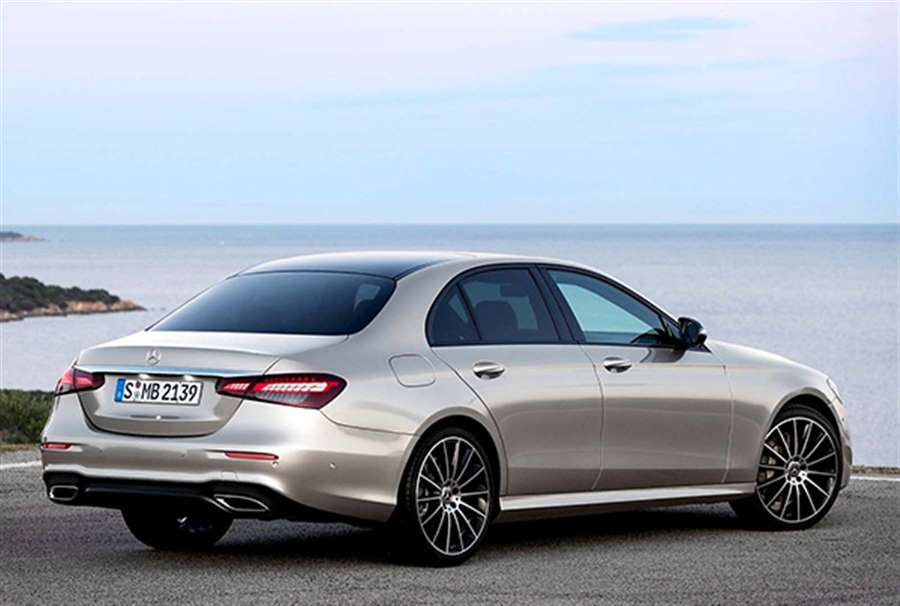
Commended
Audi A6
With a plug-in model joining the range, the high-tech, well built and spacious A6 delivers an incredible breadth of ability across the range. Audi’s usual level of infotainment and quality means the A6 is a tempting alternative to the E-Class.
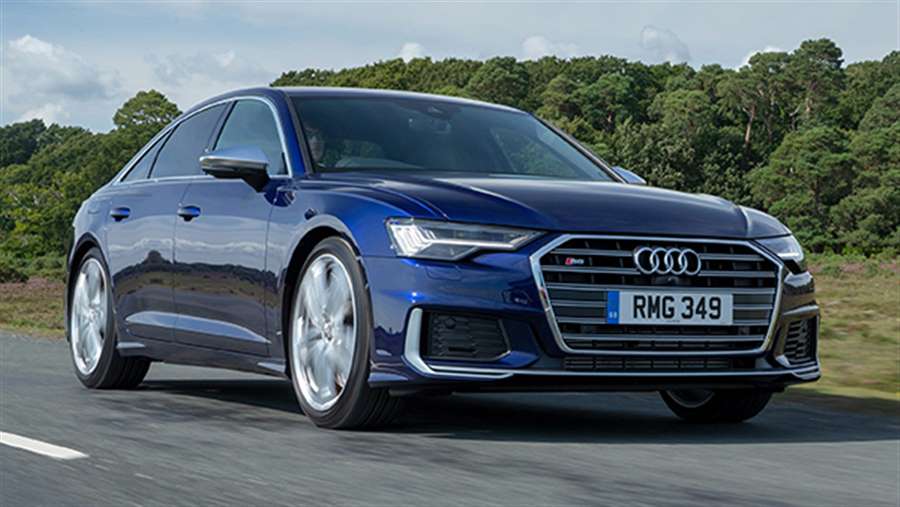
Volvo S90
If you don’t want a German saloon but do like the idea of electrification, with plug-in hybrid power offering huge performance and efficiency potential, the Volvo S90 offers a slice of Scandi cool with real eco appeal, too.
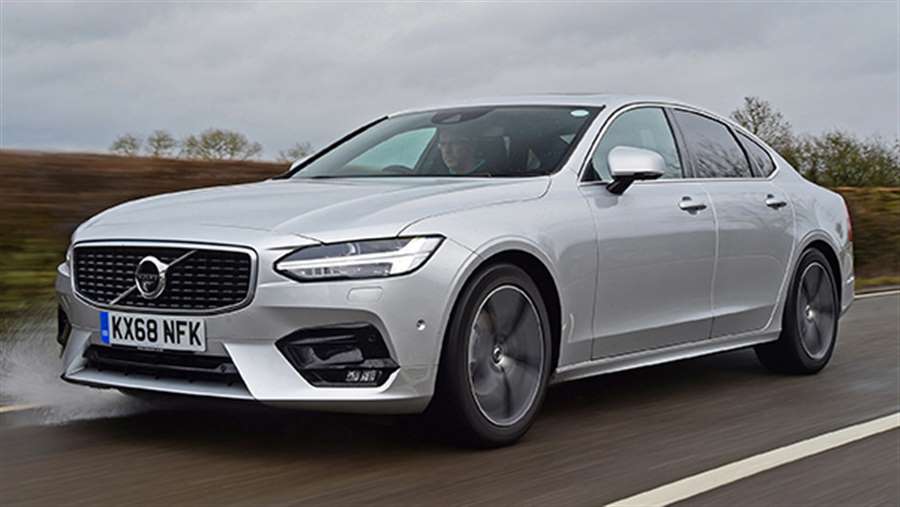
Source: mercedes-world.com

